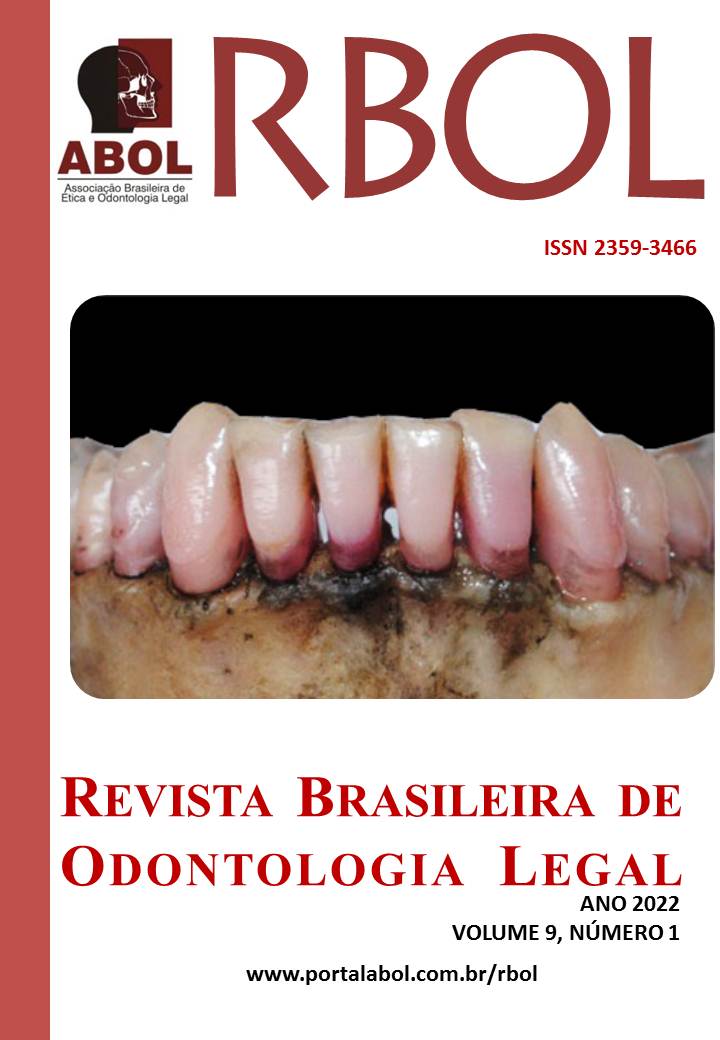Assessment of the accuracy of facial linear measurements on Horos Software
DOI:
https://doi.org/10.21117/rbol-v9n12022-415Keywords:
antropologia forense, análise crânio-facial, antropometria crânio-facial, radiologiaAbstract
Introduction: In craniofacial anthropometry, facial anatomical structures are quantitatively evaluated, and cone beam computed tomography (CBCT) has significantly contributed to refine this approach. Anthropological and morphological analysis of the skull for age estimation or, assessment of facial soft tissue thickness for forensic facial approximation, can be benefited by advancement of CBCT image reconstruction and visualization tools at open-source software such as HorosTM. Objective: This study verified the reliability and accuracy of linear measurements performed in CBCT in Multiplanar Reconstruction (MPR), in MIP visualization mode, at minimum (STmin) and maximum (STmax) slab thicknesses. Material and Method: 17 skulls from biobank of the Laboratory of Forensic Anthropology and Dentistry of University of São Paulo (OFLab-FOUSP) were selected for measurement of 10 linear distances, measured in three different ways, one directly on the skull (gold standard) and two in software (in STmin and STmax). For statistical analysis, the significance level of 5% was adopted; inter- and intra-examiner ICC (Intraclass Correlation Coefficient) was excellent. Results: The consistency of measurements between the methods in groups A (skull-STmin) and B (skull-STmax) was verified by Bland-Altman analysis. Group B showed greater measurement accuracy than group A. However, differences found in group A was smaller than 1 mm, and it does not compromise the craniometric analysis. Conclusion: Both methods are reliable for linear measurements.
Downloads
Published
Issue
Section
License
Os autores deverão encaminhar por email, devidamente assinada pelos autores ou pelo autor responsável pelo trabalho, a declaração de responsabilidade e transferência de direitos autorais para a RBOL, conforme modelo abaixo.
DECLARAÇÃO DE RESPONSABILIDADE E TRANSFERÊNCIA DE DIREITOS AUTORAIS
Eu (Nós), listar os nomes completos dos autores, transfiro(rimos) todos os direitos autorais do artigo intitulado: colocar o título à Revista Brasileira de Odontologia Legal - RBOL.
Declaro(amos) que o trabalho mencionado é original, não é resultante de plágio, que não foi publicado e não está sendo considerado para publicação em outra revista, quer seja no formato impresso ou no eletrônico.
Declaro(amos) que o presente trabalho não apresenta conflitos de interesse pessoais, empresariais ou governamentais que poderiam comprometer a obtenção e divulgação dos resultados bem como a discussão e conclusão do estudo.
Declaro(amos) que o presente trabalho foi totalmente custeado por seus autores. Em caso de financiamento, identificar qual a empresa, governo ou agência financiadora.
Local, data, mês e ano.
Nome e assinatura do autor responsável (ou de todos os autores).

